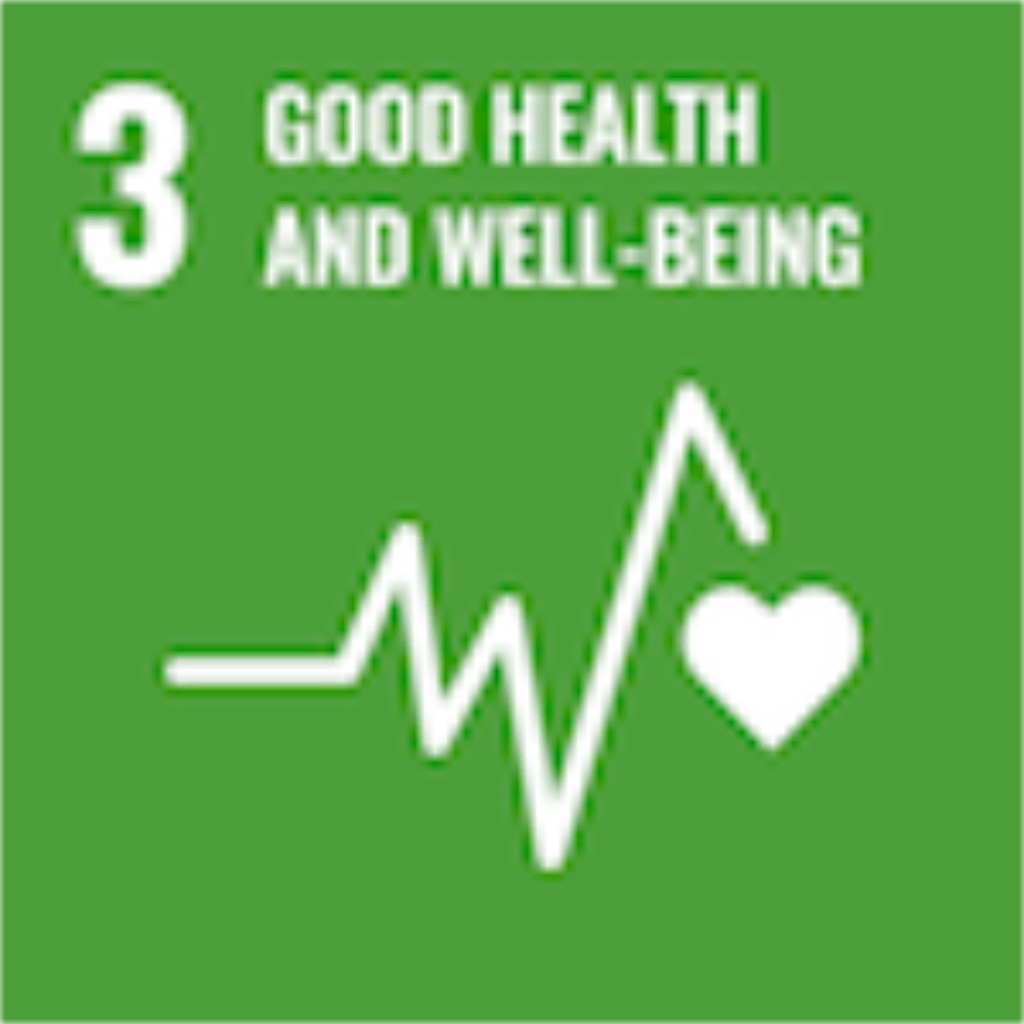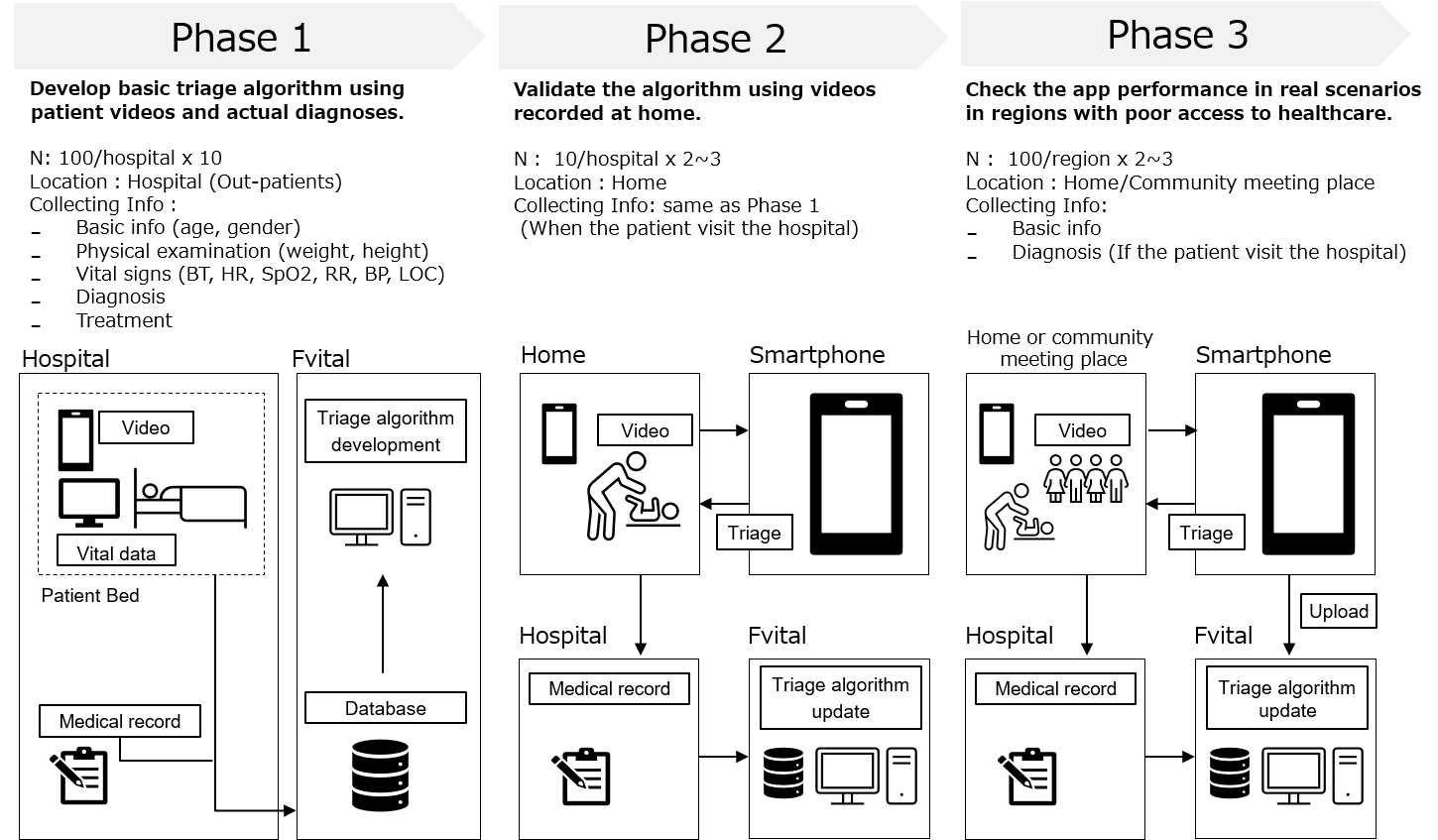Many children in the world who are dying from infectious diseases could be saved by early detection and proper treatment at hospitals. However, social issues are obstacles to such efforts, including the lack of medical literacy at home and economic conditions, as well as limited medical facilities, supplies, and human resources. To address these social issues, fvital Inc. is developing a handheld adaptive triage app (HAT). HAT determines the urgency of a patient’s medical conditions without typing information, by obtaining vital data from a half-minute video recorded with an ordinary smartphone. In addition, by considering various environmental factors and making a holistic judgment, optimal triage for patients can be achieved.
May, 2022
fvital Inc.
| Issues to be solved | Reduction of infant mortality worldwide, especially in developing countries |
| Product / Technology / Service | Acquisition and analysis of contactless vital data using a smartphone app and development of an individually optimized triage system that incorporates environmental factors of patients
Product Name: Handheld-Adaptive-Triage-Application (HAT) |
| Approach | Development of apps for acquisition and analysis of vital data, experimental research, and promotion in various regions |
| Target country / area | Cambodia, Laos, Bhutan, Myanmar, etc.
African countries such as Kenya, Ghana and Nigeria, at a later stage |
| Target year for achievement | December 2024 |
| Scale of the business | - Aiming for 50% HAT market penetration in areas with a high rate of infectious diseases in target countries by December 2024
- Target triage accuracy of 80% by March 2023 and 90% by March 2024 |
| Partner | Experimental research partner: Sunrise Japan Hospital (Cambodia) *Current status |
| Relevant target of SDGs |

3.1 By 2030, reduce the global maternal mortality ratio to less than 70 per 100,000 live births.
3.2 By 2030, end preventable deaths of newborns and children under 5 years of age, with all countries aiming to reduce neonatal mortality to at least as low as 12 per 1,000 live births and under-5 mortality to at least as low as 25 per 1,000 live births. |
Background
fvital Inc. aims to realize “a society in which children around the world can survive and thrive, grow up healthily, and make their own life choices, regardless of the environment in which they are born.”
According to the World Health Organization (2021), more than 5 million children die annually worldwide, mainly in developing countries. It is said that pneumonia, diarrhea, and malaria account for about 29% of the deaths of children under the age of 5 (UNICEF (n.d.)), although these cases could be prevented and treated. Many types of pneumonia could be treated with antibiotics, and 70 ~ 90% of deaths due to diarrhea could be prevented with oral rehydration salts. Thus, early detection and proper medical treatment could save the lives of many children. However, social issues are obstacles to such efforts, including the lack of medical literacy at home and economic conditions, as well as limited medical facilities, supplies, and human resources.
Global health accounts for only about 5% of Japan's Official Development Assistance (ODA), and we believe that substantial activities in the private sector are necessary. To address the social issues discussed above, which cannot be solved solely by financial resources, fvital Inc. will leverage technology, work with partners, and promote HAT globally. As data accumulate in the future, it could be possible to visualize and optimize the medical resources in each region.

Purpose of the project
- By developing and promoting HAT, we will reduce under-5 mortality rate caused by infectious diseases (SDGs 3.2).
- Accumulation of data enables early detection and treatment.
- Cooperation with medical institutions can reduce their burden and optimize the allocation of human resources and supplies.
Detail of the Project (How can this project address global health challenges?)

The vital data of a child is obtained from a half-minute video recorded by an ordinary smartphone, and the urgency of a medical condition can be determined. Optimal triage is carried out by holistically considering factors such as the situation of parents, surrounding medical resources, weather, road conditions, geographical conditions, and political conditions, and the recommended action will be indicated based on the probability of achieving the target goal. We use video input and icon output to assist parents in low literacy areas to understand the recommended action.
Timeline or milestones by the achievement of the commitment, KPI for monitoring activities

April 2022 – Mar 2023
Experimental Research on Basic Technologies for Handheld Adaptive Triage Application
----------------------------------------------------------------
How to proceed with experimental research (Proof of Concept: PoC)Phase 1: Collect information to determine medical seriousness based on a videoConducted in hospitals in which the seriousness of medical conditions is properly diagnosed and recorded.
Target population: Outpatient children under the age of 6
Number of patients: 100/10 hospitals
Venue: Hospital
Duration: 10 weeks
Phase 2: Assess medical seriousness with a home videoPatients at hospitals participating in Phase 1 of the PoC are asked to record themselves at home. This stage can be started after developing an app that can be judged offline from the data collected in Phase 1.
Target population: Children under the age of 6 in households with relatively immediate access to the hospital
Number of people: 10/hospital x multiple hospitals if possible
Venue: Outside the hospital (at home)
Duration: 10 weeks
Phase 3: Assess medical seriousness with a home videoVideo recorded at home to determine the seriousness of medical condition (for families who cannot easily visit a hospital)
Target population: Children under the age of 6 in households that cannot easily visit a hospital
Number of people: 100/region in areas far from the hospital where infant mortality is relatively high x multiple regions if possible, or regular monitoring at a single location in a village.
Venue: Outside the hospital (at home or meeting place in a village)
Duration: 10 weeks
----------------------------------------------------------------
June 2022 – December 2024
Experimental study of adaptive element incorporation
*About Adaptive Elements
In developing countries, factors such as parents' economic conditions, nearby medical resources, weather and road conditions, and geographic and political conditions may affect the availability of treatment. Therefore, it is essential to provide an optimal triage by holistically considering these various factors in order to reduce the mortality rate.
Example 1) Suggest the shortest route to the nearest medical facility based on road traffic information
Example 2) Propose the most cost-effective treatment according to economic conditions
Example 3) (Advanced) Propose the construction site of the hospital which can improve the prognosis of the residents.
Precondition for achieving the commitment (external funding, approval/permission by regulatory authority, etc.)
- Acquisition of external funds
- Collaboration with hospitals in Japan and overseas that can participate in experimental research
- Collaboration with local governments in Japan and overseas that can participate in experimental research
- Collaboration with distribution companies
Role and responsibility of each partner
PoC Partner:Sunrise Japan Hospital in Cambodia
References
1. WHO. (2021). Latest child mortality estimates reveal world remains off track to meeting Sustainable Development Goals. Retrieved April 26, 2022, from
https://www.who.int/news/item/20-12-2021-latest-child-mortality-estimates-reveal-world-remains-off-track-to-meeting-sustainable-development-goals2. UNICEF. (n.d.). Childhood diseases. Retrieved April 26, 2022, from
https://www.unicef.org/health/childhood-diseases Contact information
Company: fvital.Inc.
Department and person in charge: Global Health Department, Masumi Ajima
Mail address or telephone number: info"at"fvital.tech
(Please replace "at" with @)
editor:All contents including photos provided by fvital.Inc.



